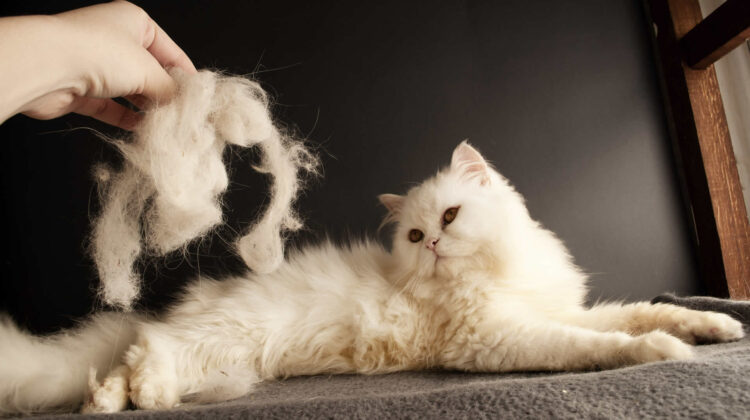While all felines shed, a few varieties shed more than others. Persians, Russian Blues, and Maine Coons are known for shedding extra. Furthermore, American shorthaired felines are among the greatest shedders of all.
How Might You Tell When Your Cat is Shedding Too Much?
Some measure of shedding is typical for most felines. However, extreme balding can be an indication of medical issues. Things being what they are, how can you say whether shedding is unusual?
You realize your feline best. In the wake of living in closeness to them, you probably know how much hair is ordinary, and you’re sensitive to occasional changes in shedding. Thus, the primary sign that your feline might be shedding an excessive amount is the point at which you notice more hair than expected.
Another piece of information: overabundance prepping. Felines groom themselves up to a fraction of the time they’re conscious. However, assuming you notice your kitty licking or scratching herself more than expected, to the point that they’re keener on preparing than different exercises, then something might be up. At long last, probably the greatest sign that your feline is losing a lot of hair is in the event that they foster unreasonable or steady going bald, known as feline alopecia. In an article for the Chicago Tribune, veterinarians Rebecca Schmidt, DVM, and Michelle Miller, DVM make sense that patches of fur misfortune and a dainty coat might demonstrate a fundamental clinical issue.
Certain purposes for Increased Shedding
More often than not, abundance shedding in felines isn’t serious. There are five significant reasons for balding in felines, all treatable with veterinary consideration:
1. Sensitivities
Skin, food, or ecological sensitivities might make felines tingle and scratch a great deal, prompting going bald. As per Kathryn Primm, DVM, composing for IHeartCats, when a feline scratches and grooms a ton, it can lose hair and even foster an optional skin disease. Despite the fact that sensitivities aren’t 100 percent treatable, they can be made do with prescription and diet.
2. Bugs
Bugs, vermin, lice, and ticks are parasites that might prompt uncovered spots and injuries. On the off chance that you’ve had insects, you know: they’re an immense aggravation, causing dry red knocks, extraordinary tingling, and balding. Assuming that you suspect your feline has bugs, converse with your vet about protected and successful treatment. Here are tips to dispose of bugs in the house.
3. Ringworm
Ringworm is definitely not a genuine worm, yet a contagious disease that causes a textured ring of missing hair. It’s easy however exceptionally infectious between felines, canines, and people the same. Your veterinarian can recommend unique shampoos and creams to treat ringworm.
4. Metabolic infection
Metabolic issues, for example, kidney illness and hyperthyroidism can cause balding in felines. These issues are not reparable, however, when gotten early, can be treatable for quite a while.
5. Stress or fatigue
Veterinarians call going bald coming about because of stress “psychogenic alopecia.” When felines are extra-focused, they may fanatically prep themselves, prompting bare patches as well as skin bothering. Treatment for psychogenic alopecia centers around pressure decrease and advancement.
The most effective method to Lessen the Impact of Shedding
Fortunately, most reasons for overabundance shedding in felines are effectively treatable. What’s more, obviously, some shedding is inescapable — that is felines! While it’s impractical to prevent a feline from shedding totally, there are ways of controlling the wreck.
Brushing your feline aids eliminate dead hair and fur, and could decrease the number of hairballs your feline removes. In addition, as VCA Animal Hospitals makes sense of, “day-to-day brushing will emphatically trim down on how much free hair and feline dander drifting around the house.” That’s uplifting news for people with sensitivities!
Diet is one more method for controlling shedding. Eats fewer carbs high in entire creature protein and a suitable equilibrium of fundamental omega-3 and omega-6 unsaturated fats will assist with keeping your feline’s jacket and skin solid.

